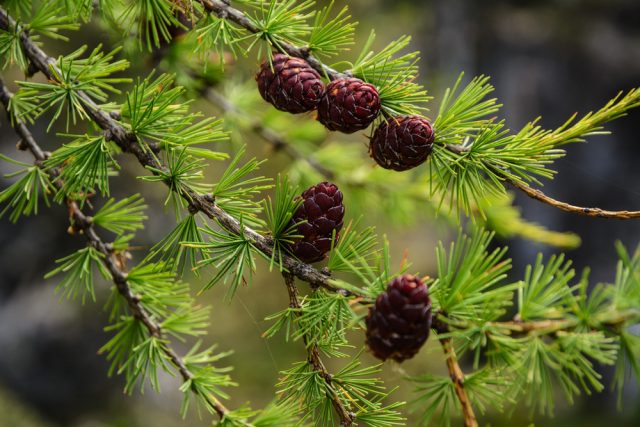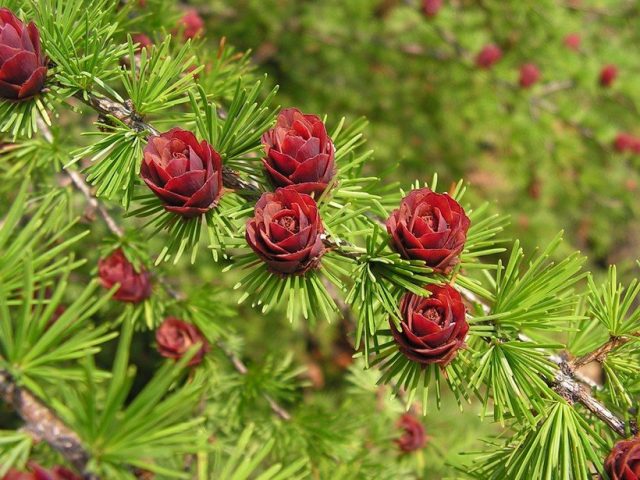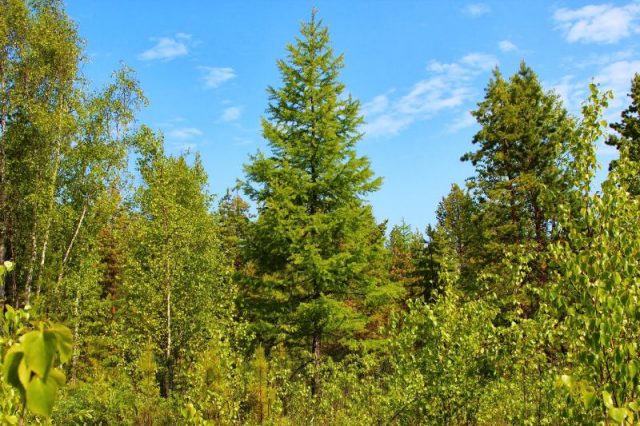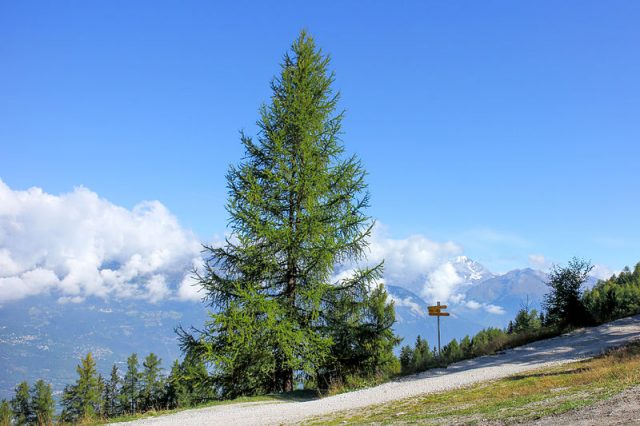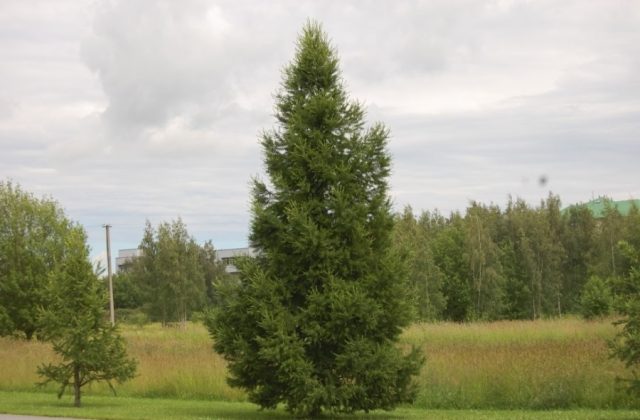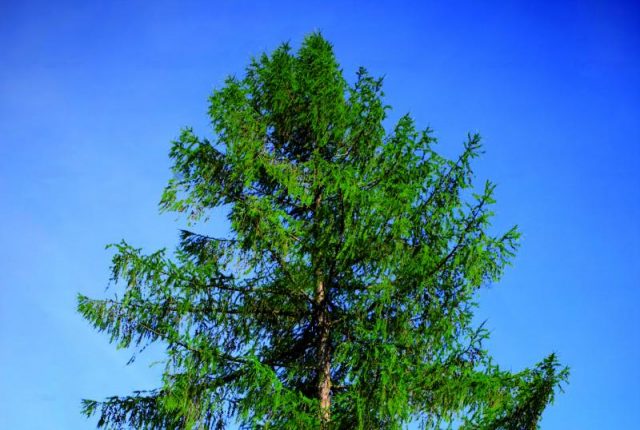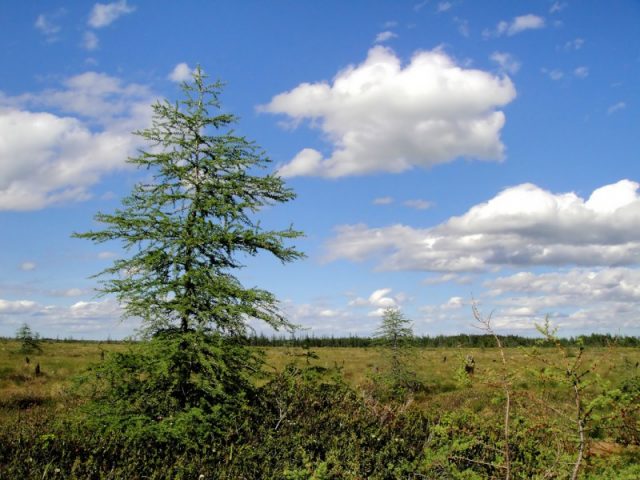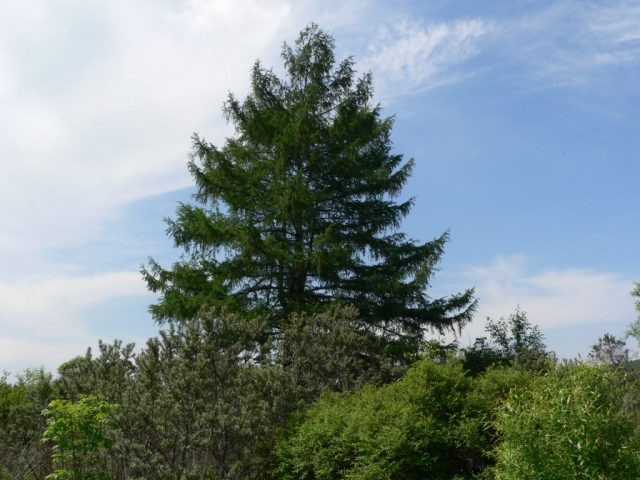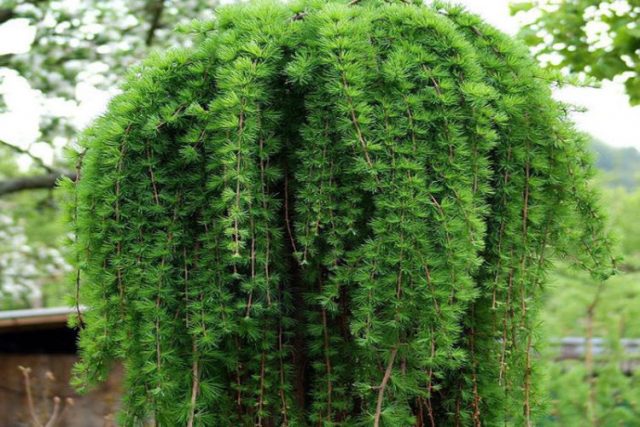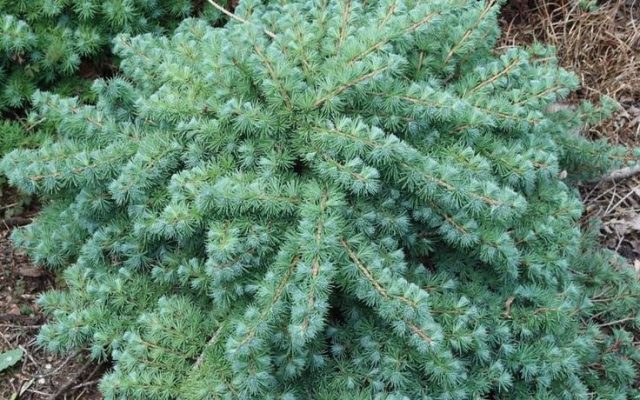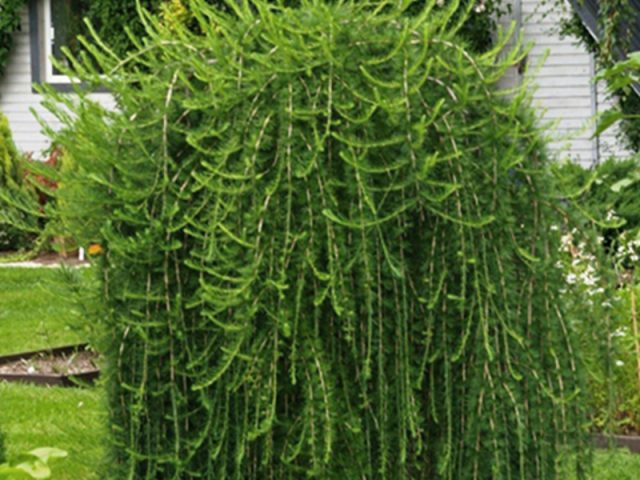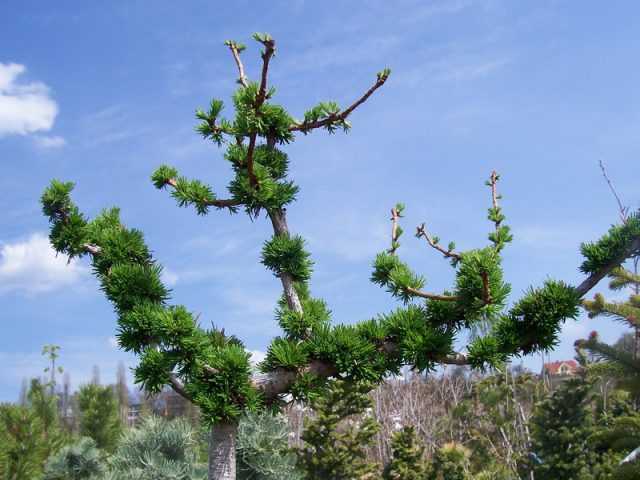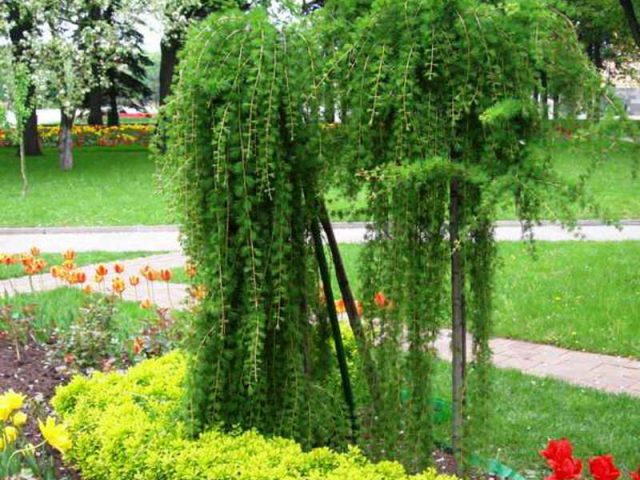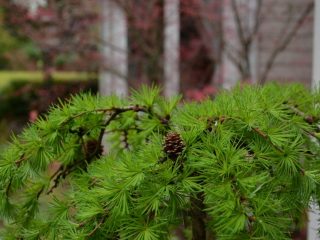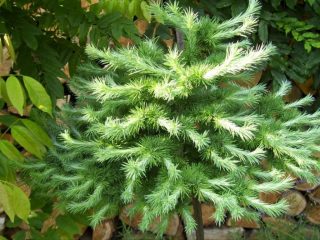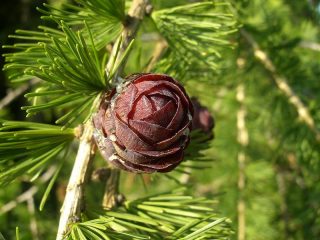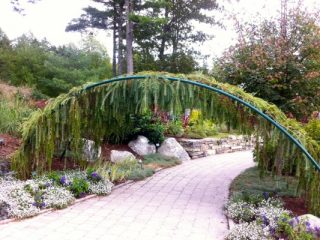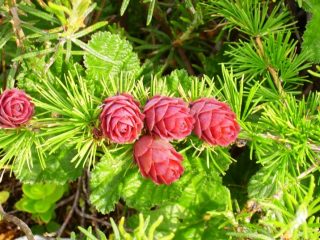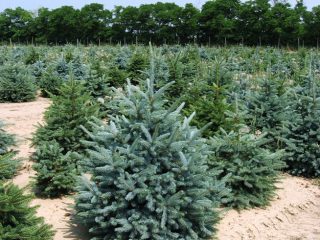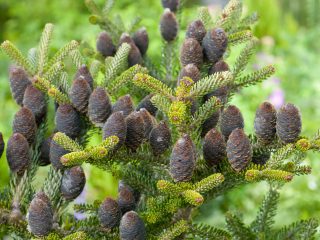Content
- 1 Where does larch grow, in which natural zone
- 2 Description of larch
- 3 Features of the structure of larch
- 4 Larch in landscape design
- 5 Types of larch with photo
- 6 Larch varieties for the garden
- 7 Why is larch useful?
- 8 How larch is used by humans
- 9 Larch in medicine
- 10 Features of caring for larch
- 11 Interesting facts about larch
- 12 Conclusion
Larch is a coniferous tree with unique characteristics and valuable economic and medicinal properties. It is interesting to know what a tree looks like and how it differs from other conifers, as well as to understand what its benefits are.
Where does larch grow, in which natural zone
On the territory of Russia, can you find a tree in almost all regions of the country? it is distinguished by increased endurance and calmly endures climatic changes. Larch grows everywhere in Siberia and the Far East, where it occupies vast natural territories, and is found in small quantities in the Urals. Can you see a coniferous tree in the middle lane? however, larch trees in the European part of Russia grow only in cultivated plantings.
The area of growth of larch in the world is Canada and the northern regions of the United States, the tree grows in the mountainous regions of Europe and Asian countries. Coniferous species are undemanding to the quality of the soil, but they prefer areas with enough sun. Larch often forms continuous forests, but it successfully coexists with other coniferous or deciduous species.
Description of larch
The appearance and description of the larch tree is truly unique. The plant combines the characteristics of deciduous and coniferous trees, has a high lifespan and a recognizable structure.
What group of plants does larch belong to?
Contrary to its name, larch is a coniferous tree and belongs to the Pine family. The uniqueness lies in the fact that of all the numerous conifers, only this species sheds its needles for the winter, thereby demonstrating features characteristic of deciduous plants.
Larch height
The maximum height of a coniferous tree can be 50 m, while the trunk girth reaches 1 m. The growth of a tree directly depends on the conditions, larch grows best in sunny regions with well-drained soils, and in swampy and low-sun areas it can remain stunted and stunted.
The length of the needles in larch
The needles of a tree can reach from 1.5 cm to 4.5 cm in length, the size depends on the type of plant, its age and height. In the photo of a tree and larch leaves, it can be seen that the needles of the tree are soft and flattened, on long shoots the needles of the plants are located one by one, and on short ones - in dense bunches consisting of 20-50 needles.
The size and shape of the larch cone
Every year, 2 types of cones appear on the shoots of a coniferous tree - yellowish male and green or reddish female. The tree cones are round or elongated, almost cylindrical in shape, and do not exceed 3.5 cm in size.
Larch crown shape
The outline of the crown of a coniferous tree depends not only on the species and variety, but also on age.Common larch at a young age has a conical elongated crown. But over the years, the branches of the tree grow, and the crown acquires a rounded or ovoid shape.
If the area where the tree grows is characterized by strong winds blowing in the same direction, then the crown can stretch in the same direction and acquire a flag-like shape.
The ratio of larch to light
A hardy and generally unpretentious coniferous tree makes increased demands on the level of lighting. For healthy and fast growth, the tree needs ample sunlight. In conditions of strong shading, it can greatly slow down its development or completely stop growth and remain stunted and weak.
How larch blooms
The flowering of a coniferous tree is not at all like the usual. It does not give flowers in the usual sense of the word, but their role is played by young cones that appear on the branches of a tree in early spring.
Unlike most conifers, larch does not bloom with green, but with raspberry or pink female cones. Therefore, in the period from late April to early May, the tree is noticeably transformed and becomes very beautiful.
How many years does larch live
Coniferous species are among the centenarians. The life span of larch is usually from 300 to 600 years. However, trees with an age of more than 800 years are also known in the world.
Features of the structure of larch
Externally and in its characteristics, the plant may resemble other conifers. But some features of larch make it possible to unmistakably distinguish it from pine, spruce or cedar.
How to distinguish larch from pine
Pine and larch have similarities, but they also have differences. The main distinguishing feature of larch is the ability to shed needles for the winter, while pine is an evergreen tree. But there are other nuances as well.
- In adult larch, the trunk is usually thicker than that of pine, and the crown is more transparent and light.
- Pine has longer needles, and along all the shoots they are arranged in a spiral in small bunches of 2 needles each. Coniferous bunches of larch can contain up to 50 needles.
- Larch lives on average up to 600 years, pine - only up to 350.
You can also distinguish trees from each other by the shape of the cones. In pine, they are conical, like in most conifers, and in larch, they are round.
Which is better - larch or pine
Wood from both trees is often used in construction. Both options have merits.
- Larch wood is much denser in structure than that of pine, therefore it is more reliable and durable.
- Highly selected larch wood has a smoother texture with fewer knots.
- The color of the larch is very beautiful - the boards can have a reddish or light brown tint. But there is also a minus - it is more difficult to choose the same color lumber, almost always the shades will differ.
In general, the properties of larch are valued much higher. But the price of its wood is also higher, the plant is supplied mainly from Siberia, drying and processing are associated with certain difficulties. Therefore, pine is still the more common budget option.
What is the difference between fir and larch
Distinguishing between larch and fir is quite simple. First of all, you need to look at the trunk - the fir is slimmer and does not have noticeable bends, besides, its bark is smooth. Like most conifers, fir stays green in winter, which distinguishes it from larch.
A characteristic feature of the fir is its cones. They sit on the shoots vertically and are directed upward, like candles. An adult fir can reach a greater height than a larch tree - up to 60 m or more in height.
Which is better - cedar or larch
Both cedar and larch are considered premium materials in construction.The cedar has the following advantages:
- beautiful appearance of wood - noble brown with a recognizable pattern;
- antiseptic properties, neither mold nor insects appear in cedar houses;
- good thermal insulation characteristics - cedar wood is very dense and thick.
The main disadvantages of cedar can be considered its high cost and strong specific smell, which not everyone likes.
Larch is not only cheaper, but also does not emit an obtrusive aroma. With proper processing, it surpasses cedar in terms of wood strength and retains heat just as well. Therefore, the properties of larch wood are more popular in construction.
The difference between spruce and larch
In a coniferous forest, larch can be confused with spruce. But a number of characteristic features will allow you to correctly determine the type of wood.
- If larch needles are long and soft to the touch, then in spruce they are usually shorter and much sharper.
- Spruce is an evergreen plant, it does not shed needles for the winter and does not change color in the fall. Larch turns yellow with the arrival of autumn, and with the onset of cold weather, its needles crumble.
- On spruce branches, the needles are arranged in a single order, while on larch they are collected in large bunches.
- Spruce gives off a more pronounced coniferous aroma.
According to the characteristics of wood, larch is much stronger and harder than spruce. Spruce boards weigh much less and are lighter in color than larch.
Larch in landscape design
Larch is a very beautiful tree in terms of landscape design. If you wish, you can grow it on your own plot.
- The tree looks attractive, even if it is planted alone in a free area of space. In summer, the tree will delight you with a juicy and bright shade of needles, and in autumn it will acquire a golden yellow color and give the site a fabulous look.
- In the composition of plant compositions, wood usually plays the role of the main accent. It can be combined with both low-growing conifers and perennial flowers.
- Low decorative varieties of wood are used to create hedges. Also, plants with drooping branches are often planted near natural or artificial reservoirs.
If you break a lawn around a lonely tree, then in the warm season you can arrange a comfortable place to relax under it by placing a chaise longue or an armchair in the shade.
In garden compositions, the plant looks best in groups with 2-3 shades of color. If an alpine slide or flower bed is too bright and variegated, the tree is simply lost against the background of neighboring plants.
Types of larch with photo
From the point of view of species diversity, the tree is represented very widely. It makes sense to highlight several of the most common species and varieties of larch with photos, which are found all over the world in both wild and decorative forms.
European
European larch, or common larch, is one of the most common plant species. It grows mainly in Western Europe in the foothills, tolerates cold well, but does not like heavy swampy soil.
In height, European larch grows up to 40 m, in the girth of the trunk it can reach 1.5 m. A recognizable feature of the species is sagging branches, the crown of the tree can be oval or have an irregular shape. In an adult plant, the bark is brown, and in young trees it is gray.
Siberian
Another common species that occupies considerable areas in Siberia, Altai and the Urals. Predominantly forms solid tracts or grows in mixed coniferous forests, rarely found in the vicinity of deciduous trees. The tree prefers podzolic moist soils and an excess of sunlight.
The Siberian variety grows to an average of 40 m, and its trunk diameter can reach 1.8 m.The shape of the crown of the tree is oval, thinned, the bark in mature trees is grayish, and in young trees it is light yellow.
Japanese
The Japanese variety grows wild on the island of Honshu in Japan. The tree has a number of distinctive features:
- Japanese larch is noticeably lower than other species - about 35 m in height;
- the crown of the plant is pyramidal, thick long branches are located horizontally;
- the needles of the plant have a bluish-green tint, which gives the tree a very decorative look.
Unlike most species, Japanese larch thrives on moist clay soils and loams. Also, this variety is distinguished by rapid growth.
American
The habitat of American larch is mainly Canada and the northeastern regions of America. The tree is quite compact in size, reaching an average of 30 m in height, while the trunk girth is only about half a meter. The crown of the American plant species is conical, formed by curved long branches, the trunk is covered with reddish bark in mature trees and dark yellow or orange in young ones. The requirements for the conditions of the tree are quite standard, it loves sunlight, but at the same time calmly refers to the low quality of the soil.
A characteristic feature of the American variety is the miniature size of the cones and needles. The needles usually do not exceed 3 cm in length. The size of the cones is on average 2 cm, but the buds of this plant have a very beautiful shape, reminiscent of rosebuds.
Daurskaya
Daurian larch is one of the most hardy coniferous plant species. Trees can grow on poor soils and permafrost, on mountain slopes and in swampy areas, and withstand severe frosts.
The maximum height of the Daurian larch is about 30 m, the trunk reaches about 0.8 m in diameter. The crown of the tree is oval, the bark is very dense, covered with deep grooves. Cones of this species in a blossoming state are similar to rose flowers and have a pronounced purple hue. The species is actively used in landscape design, since the care of a beautiful plant is minimal.
Larch varieties for the garden
In addition to species diversity, the tree is represented by a large number of decorative varieties. Varietal trees are successfully grown in gardens and summer cottages, usually they are characterized by rapid growth, a small maximum height and an interesting crown shape.
Kornik
European larch with a spherical crown, reaching 1.5 m in height and about 1.2 in crown diameter. The branches of the variety are short and grow upward, soft needles grow up to 3 cm in length, a distinctive feature is a large number of decorative buds.
Kornik is often grafted onto a stem. From spring to early autumn, larch needles have a bright green color, in autumn Kornik turns yellow, and falls off by the cold.
Repens
The European variety Repens reaches 1.5 m in height and spreads a crown 80 cm in diameter. Usually cultivated in a standard form, the characteristic feature of the plant is flexible, very long shoots falling to the ground.
"Weeping" Repens larch looks organically on the shores of small reservoirs, is used as part of alpine slides, and is also suitable for container growing.
Blue Dwarf
The variety is a Japanese variety with a maximum height of about 2 m on a trunk and a crown diameter of about 1 m. It has very beautiful needles - in the summer season, the Blue Dwarf has a bluish-green tint of the crown, and in the fall its needles turn bright orange.
Trees of this variety grow very slowly, adding only up to 4 cm per year, prefer lighted areas, but are able to tolerate a little shade.
Diana
Diana Japanese larch is an unusual variety with twisted spiral branches directed upwards.The tree is quite tall, it can reach up to 8 m in height, the crown diameter is about 5 m. The crown shape of the plant is usually spherical or hemispherical, the bark on the trunk is red-brown.
The Diana variety is often used in landscape design and is bred in gardens both in single plantings and in compositions.
Pendula
Another decorative variety of the Japanese variety with beautifully hanging shoots. It grows up to 6 m in height, with an average crown diameter of about 1.5 m.
Pendula looks good on the banks of artificial reservoirs and as part of plant compositions. The shoots of the variety can not only sink to the ground, but also lie on the ground with a green carpet. The shade of the needles of this variety in the summer is bluish-green.
Stiff Weeper
A variety of Japanese larch with a creeping crown type reaches 2 m in height and about 1 m in crown diameter. Usually grown on a trunk. The needles of the plant are bluish-green, from the point of view of growing conditions, Stif Wiper prefers sunny areas.
The variety looks spectacular in group plantings and single planting. To maintain the beauty and health of the plant, it is necessary to monitor moisture; the tree does not like swampy soil or severe drought.
Crejci
Krejchi is an unusual variety of European larch with a sparse and twisted crown up to 90 cm in diameter and up to 1.5 m high.It is characterized by very slow growth, adding no more than 10 cm per year on individual shoots, which noticeably thicken with age. The variety is used mainly in group plantings; it is necessary to plant Kreichi in an illuminated area and on well-drained soil.
Why is larch useful?
The coniferous tree is appreciated not only for its external beauty, but also for its many useful properties. The plant is used in medicine, the needles contain tannins and natural acids, ascorbic acid and essential oils. Thanks to this, infusions, decoctions and other products based on shoots, buds and tree needles have healing properties. Natural medicines effectively fight inflammation, strengthen the immune system and increase endurance, help treat sore joints and neuralgic ailments.
How larch is used by humans
Larch wood is an excellent building material. Due to its high density, larch wood has huge reserves of strength and durability, even in conditions of high humidity, it does not lose its characteristics.
The tree is used for low-rise construction, interior and exterior decoration. Floors and stairs are made of wood of this species, baths and saunas, pools, open terraces are built. Coniferous wood is ideal for use in those buildings that will subsequently be exposed to high humidity or temperature changes.
The use of larch by man has continued for centuries; in the old days, wood was used in shipbuilding. Even with constant exposure to moisture, larch wood not only does not lose, but also enhances its strength characteristics.
Larch in medicine
In folk recipes, cones and needles of a plant are mainly used - on their basis, tinctures and decoctions are prepared. The benefit of larch is that medicinal products from the plant help with rheumatism, radiculitis and gout, relieve toothache. The beneficial properties of larch needles are expressed in the fact that the plant has hemostatic properties, brings a beneficial effect on constipation.
Larch needles are often used for colds. The antibacterial and anti-inflammatory properties of the plant help to cope with coughs, reduce fever and eliminate infectious processes in the respiratory tract.
Features of caring for larch
Growing a tree is not particularly difficult.There are some general rules to keep in mind.
- The conifer loves light and should not be planted in shaded areas.
- The tree does not tolerate drought and swampiness, the soil for this plant must be selected light and with good aeration, if necessary, drainage should be provided.
- Watering the tree is carried out as needed; during periods of drought, water should be applied under the trunk 1-2 times a week.
- For coniferous trees, it is imperative to carry out annual sanitary pruning. Decorative haircut is carried out to level the crown and only for young trees.
Interesting facts about larch
Several interesting facts are associated with the unusual coniferous tree larch.
- This coniferous species is the most abundant in Russia. However, in terms of prevalence, it is less common than pine or spruce, mainly larch forests are concentrated in Siberia and the Far East.
- Despite the huge natural reserves of coniferous species, it is far from the most popular in logging. The reason is that the tree cannot be floated along rivers in the traditional way - due to its high density, it sinks almost instantly. Thus, additional transportation costs are required for the procurement.
Over the years, the density of larch wood only increases; it is very difficult to drive a nail into a well-dried tree. Structures and decorative elements made of this breed have been preserved for centuries. For example, larch piles still support Venice, erected in the Middle Ages, the decoration and cladding in the interiors of old estates and palaces is perfectly preserved.
Conclusion
Larch is a coniferous tree with unique characteristics and many beneficial properties. It is used everywhere, in folk medicine and in construction, in repairs and decorative finishes, when creating beautiful landscapes in parks and gardens.
